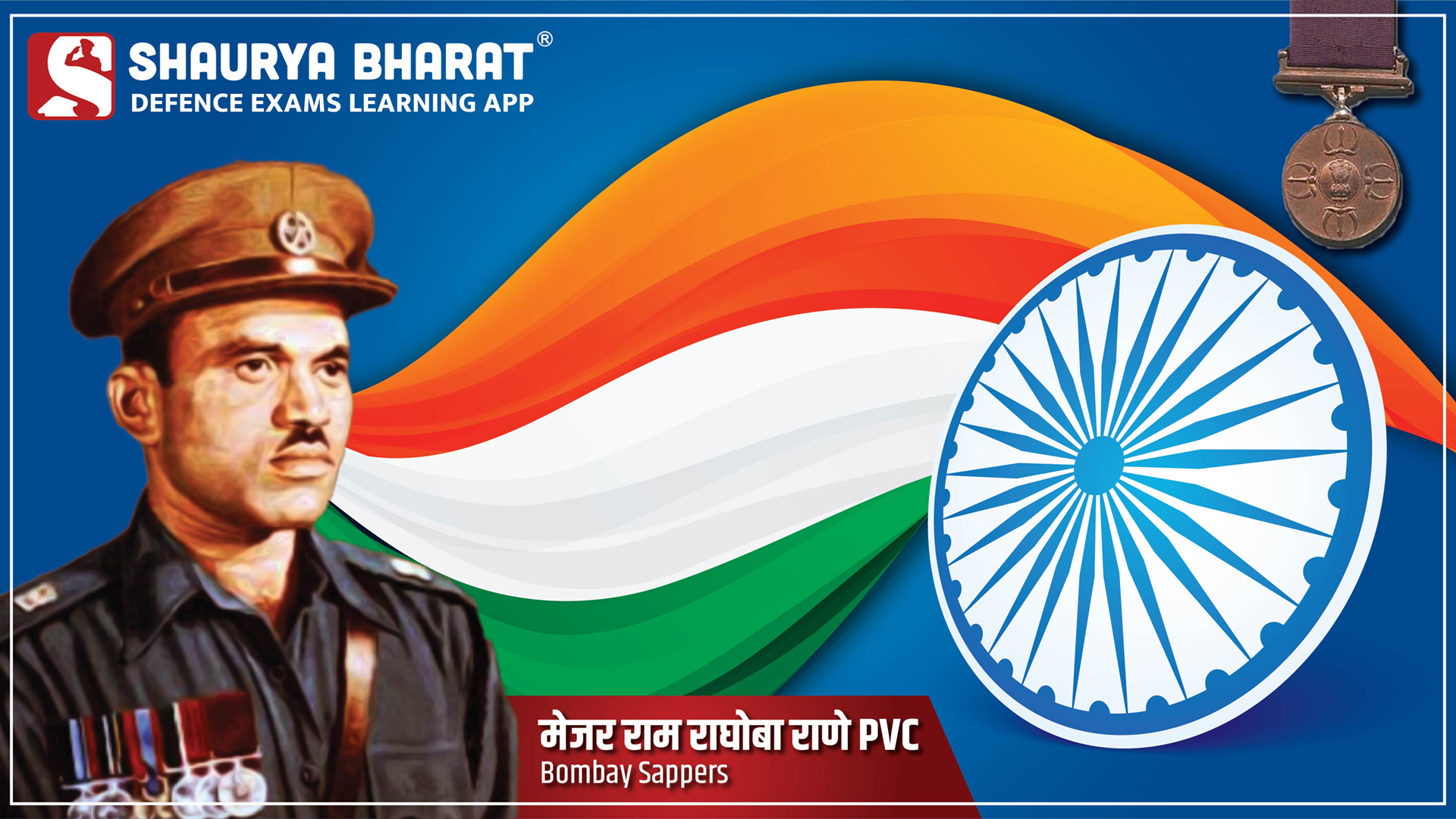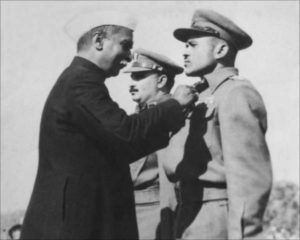Major Rama Raghoba Rane
With clear aim and firm resolve every target is penetrable. Listening to stories of Arjun aiming at the birds eye, could’ve been the lesson that stuck with young Rama Raghoba Rane forever. Shooters are modern archers, the core qualities for both remain the same, Rama manifested these qualities in himself. Taking deep breaths, he would remain calm and composed, his hands firm as his resolve and unblinking eyes set on target, between the pauses of his breath he would squeeze the trigger. His gaze would follow the puff of dust behind the target. He had developed himself into a good marksman, so good that he could carve out his name on a target. Even destiny couldn’t deny him his target once he’d set his mind onto it.
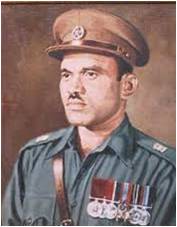
Patriot is Born
Rane came from a lineage of warrior race that was an offshoot to Rajput ranas that had settled in north Kannad districts of Mumbai. On 26 June 1918 in a small village of Chendia, in Karwar District, of then Bombay Presidency under British India (now Karnataka, India) a boy was born to R P Rane, a police constable from Chendia village. Serving under the British raj Rama’s father had to face frequent transfers that effected their family and made young Rama’s education chaotic at best.
Despite this Rama showed great potential and as a kid excelled in all kind of sports. Sports became his fascination throughout his life. Back then India was striving hard to gain its independence from its foreign perpetrators. His childhood was spent in midst of the nationalist movement occurring in the country. Even as a young kid he took great interest in it and was inspired by leaders of the freedom struggle. Non Cooperation movement initiated by Mahatma Gandhi influenced him profoundly. He was a patriot at heart. Rama could never hand over the reigns of his life to someone else, then how could he ever accept his motherland being ruled over by overseas masters. India was going through the toughest parts of struggle, anyone who raised their voice against the Raj was imprisoned and tortured and often executed. Sensing the inclination of his son towards the cause and concerned about his safety, Rama’s father moved back to his parental village to keep Rama away from the ongoing agitations.
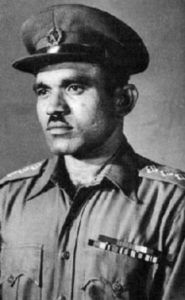
Warrior finds his calling
At the age of 22, Rane decided to join the British Indian Army and On 10 July 1940, Rane enlisted in the Bombay Engineer Regiment. He always believed he can do better and that he was made to do great things. It was his conviction that made him to strive for excellence .He passed out as the “Best Recruit”, and was awarded the Commandant’s Cane. Subsequently, he was promoted to Naik
After his training Rane was posted to the 28th Field Company, an engineering unit of the 26th Infantry Division. By then Second World War was in full swing and his company was sent to fight the Japanese in Burma. Away from home, on a foreign soil, he fought hard. Looking at his efforts, he along with his two sections, were hand-picked by his company commander. They were given the objective to destroy key assets at Buthidaung and then be evacuated by the Royal Indian Navy. With flawless planning and courageous execution the objective was soon achieved, unfortunately expected pickup did not happen. Rane and his men bravely crossed a river and astutely evaded the patrolling Japanese troops and safely reached their lines. For his courageous action, he was immediately promoted to Havaldar
Indo-Pakistani War of 1947
Britishers before exiting sought to make their subjects bleed one last time and divided it into two nations. blood that spilled after was redder than the red ink that divided the maps. Irreparable loss of life and property was felt by both sides. Even in such dark times Pakistan choose perfidy.
In 1947, following independence he was transferred to Indian Army , For his persistence and leadership qualities, Rane was selected for a short-service commission and was formally commissioned in the Corps of Engineers on 15 December 1947 as a second lieutenant. He was strict and disciplined, immaculate in his dressing and his food habits and an avid follower of all sports and maintained these qualities throughout his life. His life is paradigm to hard earned success.
Pak Army planners sand-mapped annexation of the strategically crucial State of Jammu and Kashmir. Operation Gulmarg, was Pak Army’s code name of Kashmir incursion on 22 Oct 1947. In November 1947 the Indian troops inflicted a crushing defeat on the invaders who lost nearly 600 men. The defeated troops withdrew and escaped from the valley.
On 18 March 1948, Jhangar, lost in December 1947 to the Pakistanis, was recaptured by troops of the Indian Army, which then to maintain pressure started to move towards Rajauri from Naushahra sector.
Rane’s company was attached to 4th Dogra battalion which had recaptured some posts in Naushahra sector in Jammu and Kashmir. But the tanks couldn’t move forward as the way was rigged with minefields and roadblocks.
Herculean Task
On 8 April 1948, the 4th Dogra Battalion advanced to Rajauri capturing Barwali ridge, eleven kilometers north of Naushahra. The battalion’s advance beyond Barwali was obstructed by the increasing number of roadblocks and minefields. As Rane and his team started clearing a minefield, amidst mortar fire from the Pakistanis. two sappers were martyred five others, including Rane were wounded. Despite this, by the evening of 8 April, Rane and his surviving men cleared the minefield which enabled the tanks to move forward. He was a selfless man who always thought of others before him. Once the tanks had passed through he knew the danger still persisted. Enemy forces remained at large and could cutoff or ambush the advance. He continued to work tirelessly through the night to create a safe lane for the tanks and for administrative column to pass .
The next day unnerved by ongoing heavy artillery and mortar fire from the Pakistanis his section worked for twelve continuous hours to clear mines and roadblocks. By the evening he faced obstacle of large pine trees, he was adamant to make a clear path for the tanks to move in the morning. But his superior considering the heavy enemy fire and dying daylight for his safety insisted that he rest. On 10 April, Rane got up early and resumed work on the obstacle that had not cleared the previous night.
This allowed the 4th Dogra Battalion to advance another thirteen kilometers until it encountered another major roadblock. The Pakistani forces were situated on the adjoining hills and able to fire on all approaches to the block, making its destruction problematic. Rane drove a tank to the roadblock and took cover behind the tank while blasting open the roadblock with mines, opening the road before the end of the night. The very next day, Rane worked for another seventeen hours to open the road to Chingas, which lay half-way between Rajauri and Naushahra.
During the period from 8 to 11 April, he had made a significant contribution in the Indian advance to Rajauri. His work not only cost the Pakistani forces about 500 dead and many more wounded, but also saved many civilians in the area from Chingas and Rajauri. For his tireless and persistent efforts and exemplar display of leadership and courage in the face of life threatening danger Second Lieutenant Rama Raghoba Rane was awarded the Param Veer Chakra on 21 June 1950.
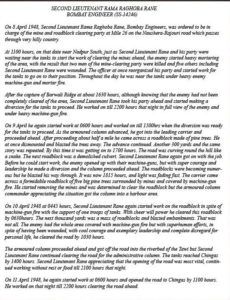
Legacy of Major Rama Raghoba Rane
Rama continued to serve even after his heroic display of courage valor and sacrifice. He always believed he was destined for greatness and worked hard to breath it into existence. He retired with the rank of major on 25 June 1968. During the course of his military career, he was mentioned in dispatches five times. Subsequently he was employed as a member of the civilian staff of the Indian Army. He passed away in 1994 at Command Hospital, Southern Command in Pune. Upon his request his last rites were performed at the BEG Centre with full military honors.
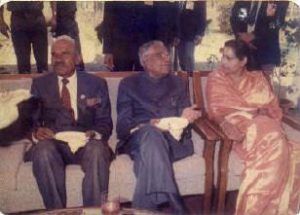
Later Shipping Corporation of India named an oil tanker on Rama Raghoba Rane’s name which came into service in 1984. A statue commemorating him was inaugurated alongside the INS Chapal Warship museum.
Rama Raghoba Rane dedicated his life to serve the nation. He remained a true patriot at heart till his last breath. His life and work radiate the lessons of discipline, determination and courage. He shall remain immortal in annals of history and our memories. His actions will continue to inspire others for generations.
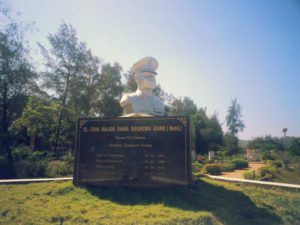
Shaurya Bharat Team salutes his valor and sacrifice. We shall never forget his dedication and bravery, and continue to be inspired and inspire others by his actions.
Jai Hind!

